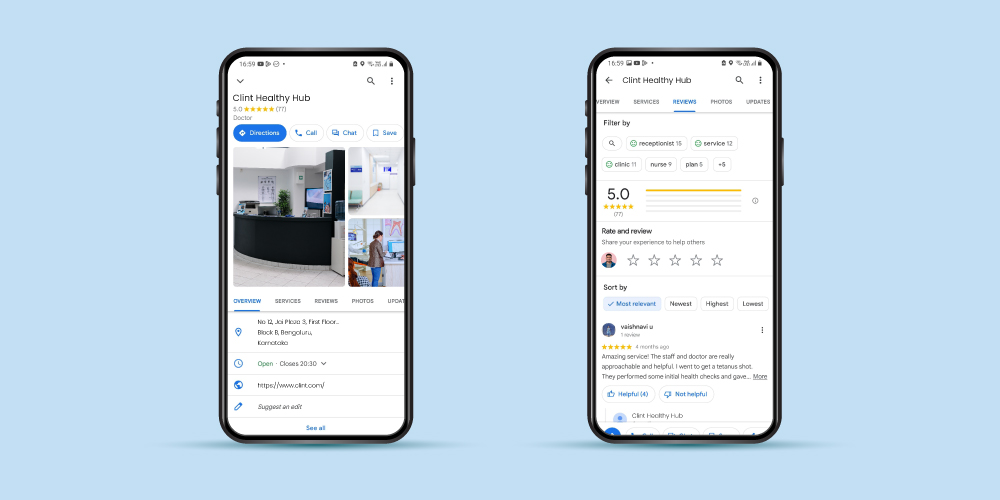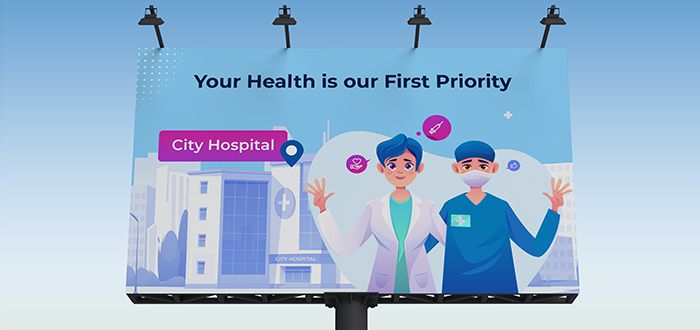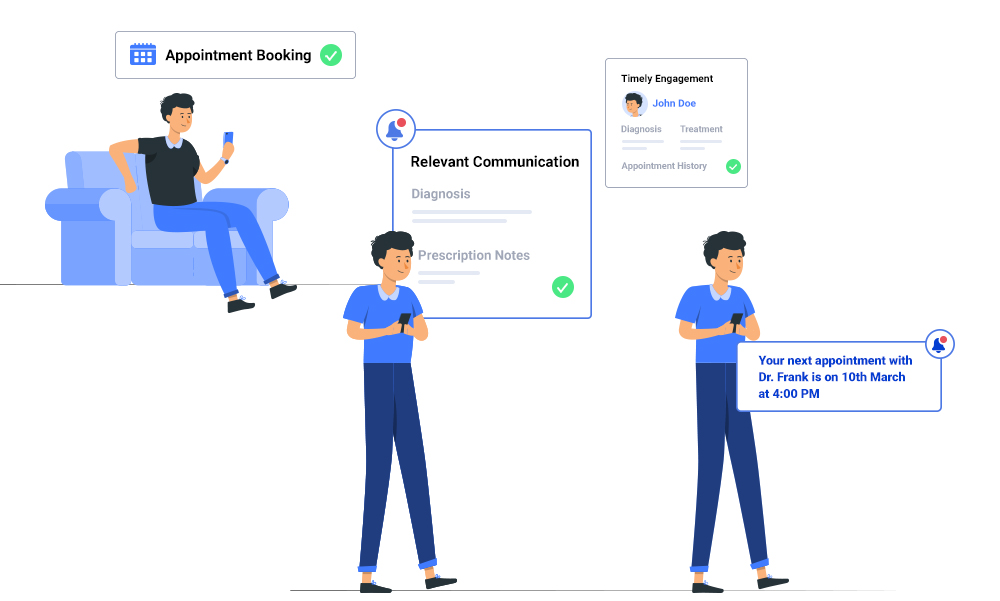Are you a healthcare provider seeking to expand your patient base and drive growth in your practice? But not sure how to do it?
To help you, we’ve put together some proven techniques to attract more patients and boost your revenues.
In this article we have covered some of the most common challenges the healthcare industry faces in acquiring new patients. We have also shared solutions you can implement to build a strong patient acquisition strategy.
Let’s get started!
Challenges and solutions for building a patient acquisition strategy
1. Limited online visibility
Limited online visibility makes it difficult for prospective patients to find you. Many healthcare organizations either have no or incomplete online profiles.
If you have limited online visibility, patients may need help to gather basic information like the services provided to make an informed decision. Not having access to accurate service details creates confusion among the patients and reduces credibility.
Here is how you can improve your online visibility.
1. Create a Google Business profile

Research says 7% of all Google searches are health related. A robust online presence can open multiple sources for driving new patients to your healthcare service.
The first step to this is to create a Google Business profile. A healthcare Google Business Profile offers a quick look at the information the searcher may want to know about your practice.
Along with attracting new patients, it also helps with your local SEO ranking and drives more patients to the website.
You can go through this article for steps to create a Google business profile.
2. Build an interactive website
The next step would be to create an informational and user-friendly website. Include all the essential details about services. Provide various methods to contact you.
For example, including an appointment booking option on your website can be a direct source for capturing new patients.
Here are a few tools you can use to build your medical website as a part of your patient acquisition strategy.
- Wix
Wix is the most popular tool used for building medical websites. It is versatile, compatible, and has advanced features as a medical website builder.
With ready-to-use medical templates for doctors, clinics, and hospitals, you can create a professional page in minutes. It also has various SEO options to ensure better reach and ranking.
Rating: 4.2 out of 5 (G2)
Pricing: Starts from $16 per month
- Appypie website
Appypie is an AI website builder for medical professionals.
With the drag-and-drop functionality, you can easily add and edit content, including services, doctor profiles, appointment scheduling, and patient testimonials.
It integrates seamlessly with popular healthcare platforms and software, enabling efficient patient records management, online bookings, and telemedicine options.
Rating: 4.7 out of 5 (G2)
Pricing: Offers a free plan
3. List your organization on third-party platforms
Listing your organization on third-party platforms is a smart patient acquisition strategy.
By creating profiles on healthcare directories, review sites, and online platforms, you can increase your visibility to potential patients searching for providers in their area.
These platforms offer a convenient way for patients to find and evaluate healthcare options, making it easier to discover and connect with your organization.
Here are a few platforms where you can list your healthcare services:
- Practo
Practo is a comprehensive healthcare platform that connects patients with doctors, clinics, and hospitals. With Practo, patients can easily find and book appointments with healthcare providers, access digital health records, and avail online consultations.
- Lybrate
Lybrate is a trusted online medical platform that offers personalized healthcare solutions. Patients can consult doctors, ask health-related questions, book appointments, and access comprehensive health information and resources.
4. Invest in digital marketing
- Optimize for local SEO
Most patients start their search for healthcare services online. SEO helps you to make sure that your patients can find you easily. You can optimize your website to appear at the top of the search list. But this is a game you win with patience.
Here are a few fundamental points to include in your SEO strategy:
- Create a Google Business Profile
- Collect patient reviews
- Get listed on online directories
- Explore referral channels, or reach out to bloggers/webmasters who write about healthcare
- Create and add location-specific content and pages
- PPC advertising
While SEO can take months to start delivering results, PPC, on the other hand, can begin generating new patient inquiries right from the start.
Healthcare market spend would reach US$1.35 bn on ads in 2023. Running paid ads can help you get more patients for your practice within a short period. You can precisely target people through PPC campaigns according to your practice and geography.
- Social media advertising
Using social media wisely can help you to generate new patient inquiries through organic and paid methods.
People use social media not only as a communication platform but also to gather information and guidance.
Creating relevant and educational content on social media can help you build credibility and trust among the patients. You can post blogs, videos, and infographics and engage with patients. This also impacts your SEO ranking.
Facebook ads are another method to generate new patient inquiry. Facebook allows you to precisely target your audience and reach directly to the people relevant to your services according to their past interests and actions. You can also use Facebook as a remarketing channel.
5. Traditional marketing

While digital marketing and all online sources are essential, we cannot ignore the importance of traditional marketing.
Print media such as banners, newspapers, and billboards can help you in physical outreach. This can help you create more local visibility where most potential patients reside.
2. Complex appointment booking process
Imagine you want to book an appointment with a clinic. You go to their website and call on the number provided, but no one answers. Then you try booking online but see no slot according to your convenience. This is bound to leave you frustrated.
There are two main reasons for losing the patient in the above example:
1. Limited patient communication and engagement
Patient engagement is a vital part of the patient acquisition strategy. Effective communication with patients will help you improve patient experience and satisfaction and, thus, will result in more patient intake.
Include multiple channels for communicating and engaging with patients like social media, blogs, websites, SMS, WhatsApp, etc.
Create a patient engagement program to be with your patients throughout their journey. When you receive an inquiry, connect with them to understand their needs and guide them through the process. Send them reminders before the appointment and re-engage with them post-consultation. This adds to the overall experience and helps you get reviews and more referrals.
Here are the top two types of software you can use to improve patient relationships and engagement.
- Healthcare CRM
Healthcare CRM helps organizations manage patient relationships effectively, streamline workflows, and improve overall patient satisfaction.
It enables healthcare providers to track patient interactions, enhance communication, and deliver personalized care, ultimately leading to better patient outcomes and organizational success.
Here is a healthcare CRM you can implement as a part of your patient acquisition strategy.
- LeadSquared
LeadSquared’s healthcare CRM platform helps you start meaningful conversations with patients according to their needs. You can use automated responses for web inquiries and convenient click-to-call features with built-in dialers to communicate effectively and efficiently.
Rating: 4.6 out of 5 (G2)
Pricing: On request
- Chatbots
Chatbots are a popular choice to interact with prospective patients on websites. It can provide quick solutions to their inquiries and also help them book appointments.
Chatbots not only save your help center or front desk staff’s time but also act as a 24/7 available assistant.
Here is a healthcare chatbot you can implement as a part of your patient acquisition strategy.
- Chatbot
Chatbot is an AI platform that supports patient engagement and improves communication in your healthcare organization.
Rating: 4.4 out of 5 (G2)
Pricing: $50 per month
2. Not offering convenient appointment options
Many healthcare organizations have restricted OPD timings. A clinic that is available only between 8 am and 6 pm may not be helpful for working adults or parents.
Limited appointment options during traditional working hours can be one of the reasons why you are not getting more consultation bookings.
Patients require flexible consultation hours to see the doctor outside of work or school hours.
But it may not be possible for all healthcare providers to provide their services 24/7. In this case, consider including teleconsultation in your patient acquisition strategy.
Providing a telemedicine option will help you go beyond your geographical limitations and reach new patients. This expands your potential patient base and allows you to provide accessible and flexible care. It will also help you add more slots to your schedule.
Here are the top 2 software to provide teleconsultation services:
- Spruce Health
Spruce Health is an all-in-one HIPAA-compliant platform built for telemedicine requirements. It aligns and complies with HIPAA regulations and standards.
Rating: 4.8 out of 5 (G2)
Pricing: Starts from $24 per user per month
2. Mend
Mend is a telehealth platform designed for modern doctors. It offers free and scalable solutions for practices of all sizes.
With Mend, you can connect with your patients easily through messaging, video, and forms using any device. It’s entirely HIPAA compliant, ensuring the security of your patient data.
Rating: 4.7 out of 5 (G2)
Pricing: Offers a free plan
3. Maintaining online reputation
Do you know that 81% of consumers are unsatisfied with their healthcare experience?
Long waiting times, campus hygiene, doctor friendliness, ease of booking an appointment, etc., are common causes of patient dissatisfaction.
Today they don’t hold back when they want to voice their unhappiness by leaving reviews on your website or social media pages.
Thus, not investing in online reputation management can also lead to lower patient acquisition rates. Include activities to maintain your online reputation in your patient acquisition strategy.
Here is how to maintain an online reputation
94% of healthcare patients go through online reviews before making any decision.
Online reviews on platforms like social media, Google Business profile, or your website reflect your services’ quality. Thus, it is crucial to check and respond to all the reviews regularly.
While it always feels good to hear positive feedback, it is equally important to note the negative ones.
First, address it and try to get in touch with the patient and make amends if possible. Take their feedback as learning and apply it to improve patient satisfaction. Collect feedback from patients after every appointment.
You can use a healthcare CRM here as well to automate the process of feedback collection.
4. Patient no-shows
Research says patient no-show rates can be as high as 80%.
No-shows primarily happen among young, single/unmarried people, people who have socioeconomic barriers, have psychosocial problems, or have no medical coverage. There can be multiple factors leading to no-shows. Some of them are:
- Forgetting about the appointment
- Not receiving the expected slots
- Anxiety about the procedure or fear of receiving bad news
If no-show rates are high at your facility, you may want to rework your patient acquisition strategy. Try to maintain a constant connection with patients throughout their journey.
You can implement LeadSquared to automate the process and send reminders for appointments and personalized messages.
How can LeadSquared help you build an efficient process to acquire more patients?
LeadSquared provides a HIPAA-compliant healthcare CRM solution with patient experience management and marketing automation software.
It helps capture inquiries from multiple sources and automate the lead distribution process. With the marketing automation software, you can automate workflows like appointment confirmation, reminders, collecting feedback, and more to create a superior healthcare experience for your patients.
Listing your organization on third-party platforms is a smart patient acquisition strategy.
By creating profiles on healthcare directories, review sites, and online platforms, you can increase your visibility to potential patients searching for providers in their area.
These platforms offer a convenient way for patients to find and evaluate healthcare options, making it easier to discover and connect with your organization.
Here are a few platforms where you can list your healthcare services:

The best part is you can integrate it with your existing EHR/EMR systems and other software.
For instance, Practo used LeadSquared healthcare CRM to reduce their turnaround time and increase conversions.
“This has been one of the best decisions we have made. We have already saved 6-8 months’ worth of development costs and effort. Our daily call center efficiency per agent has increased by 60%. We are also able to measure everything much better.”
-Siddhartha Nihalani, Co-founder, Practo
If you are also lookin gto achieve similar results, talk to our expert today.
Patient acquisition and retention go hand-in-hand
While acquisition is one of the main goals of every medical practice, patient retention is an aspect that is frequently overlooked.
You may have spent a significant amount of money to acquire a certain number of patients and to get them to visit your medical practice, but what happens next? Do you let them go? Or do you do everything you can to keep them coming back so that you can continue to build your business?
Patient retention is one of the best ways to ensure that your medical practice is continuously growing.
The good news is that most patient acquisition strategies can also be a part of your patient retention strategy.
For example:
- Collecting feedback post-appointment will help you make amends if a patient has had a bad experience.
- Engaging with your patients regularly builds a connection with them and influences their future decisions.
Conclusion
The healthcare industry has evolved a lot in the past few years. People have become more aware of their choices and have more options. We covered some challenges and strategies you can implement to get new patients for your organization.
You can use LeadSquared for better implementation of your patient acquisition strategy. To learn more, book your personalized demo today!
FAQs
Patient acquisition means attracting and acquiring new patients for your healthcare facilities for new appointments. In contrast, patient retention refers to building long-lasting relationships with existing patients for repeat visits.
Attracting and acquiring new patients for your healthcare organization is called patient acquisition. It involves various marketing activities to increase awareness about your services, generate more inquiries, and convert them into consultations.
Patient acquisition is essential for the stable growth of a healthcare organization. A patient acquisition strategy ensures you always have the edge over the competition. Additionally, acquiring new patients also leads to word-of-mouth referrals, further expanding the patient base and enhancing the organization’s reputation.









